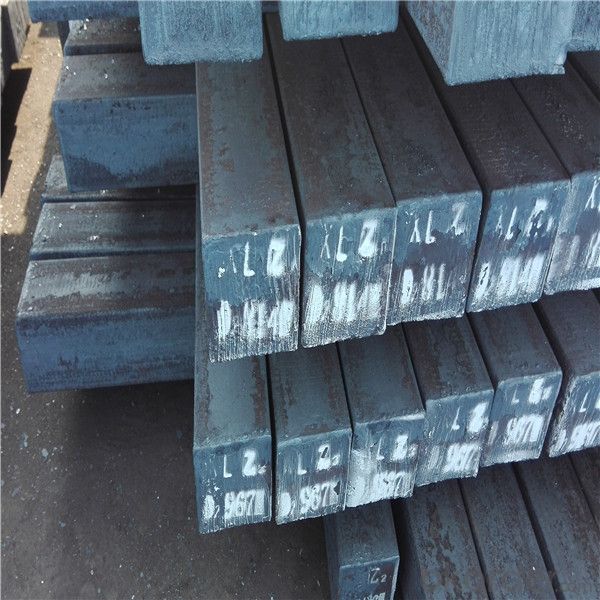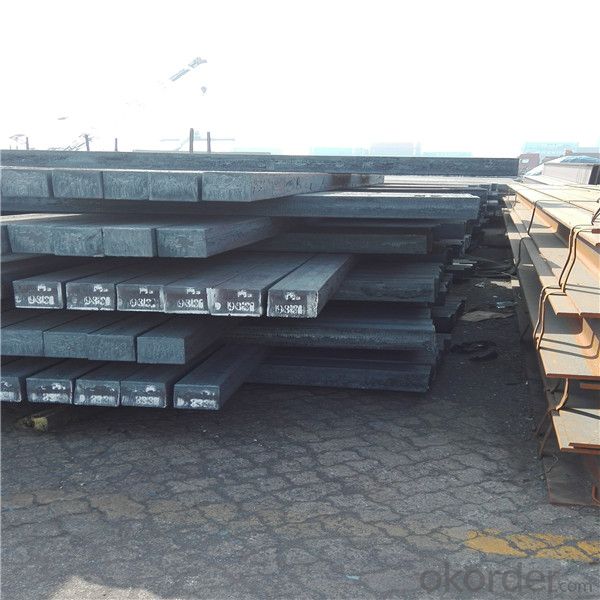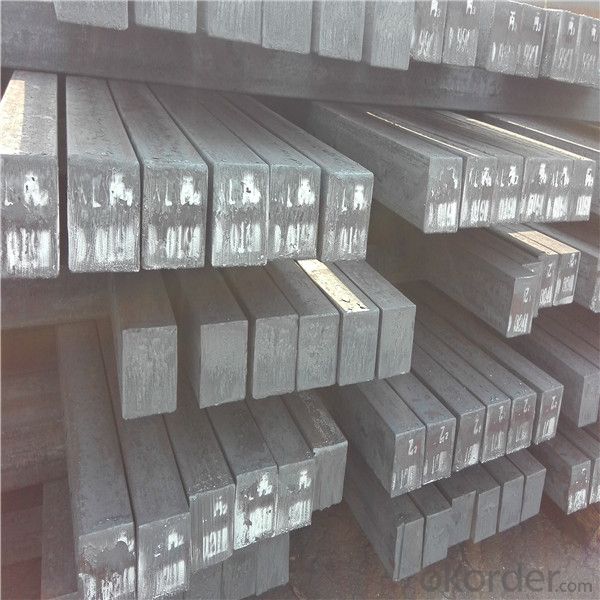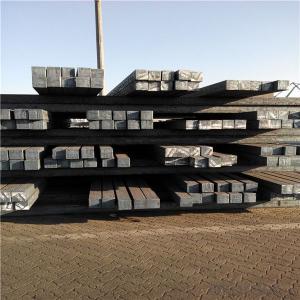STEEL BILLET 120MM/130MM/150MM made in China
- Loading Port:
- Tianjin
- Payment Terms:
- TT OR LC
- Min Order Qty:
- 1000 m.t.
- Supply Capability:
- 17532 m.t./month
OKorder Service Pledge
OKorder Financial Service
You Might Also Like
Item specifice
Steel billets have distinct characteristics as compared with already furnished steel bars and products.
Billets have a specific grain structure, which enables the metal to be processed more intricately. Steel
billets are also known for their malleability and ductility, especially when exposed to varying temperatures
during shaping and molding.
The billet is mainly divided into two kinds from the shape:
Slab: cross section width and height of the ratio of the larger, mainly used for rolling plate.
Gade:
Standard | C(%) | Mn(%) | S(%) | P(%) | Si(%) |
Q195 | ≤0.12 | ≤0.50 | ≤0.040 | ≤0.035 | ≤0.30 |
Q235 | ≤0.20 | ≤1.40 | ≤0.045 | ≤0.045 | ≤0.35 |
Q275 | ≤0.22 | ≤1.50 | ≤0.045 | ≤0.045 | ≤0.35 |
20MnSi | 0.17-0.25 | 1.2-1.6 | ≤ 0.050 | ≤ 0.050 | 0.40-0.80 |
3SP | 0.14-0.22 | 0.40-0.85 | ≤ 0.050 | ≤ 0.040 | 0.05-0.15 |
5SP | 0.28-0.37 | 0.50-1.00 | ≤ 0.050 | ≤ 0.040 | 0.15-0.30 |




Other Specifications
Size :100mm to 165mm
Length:6~12meters
Squar Tolerance: ±4
Length Tolerance: +100mm
Romboidity/Difference Diagonals: no more than 0.7%
Camber: no more than 1.5%(%)
Twist: no more than 3 degrees per 1 meter length
Our Advantage
* Professional Personnel of Steel Trading
* Strong Steel Industry Background
* Conveniently Geographic Location
Our Commitment
* Sincere, Practical, Efficient and Developing
* High Quality Steel Production
* Competitive Price and Timely Delivery
Packing :
Within 30 days
1.Standard export package
2.In bundles with steel strips
3.As the requirements of the customers
FAQ:
Q: How to get quotation?
A: When we receive your detailed enquiry, we will set the best price based on standard,
steel grade, outer diameter, wall thickness, quantity, country.
And we will send quotation to your mailbox.
Q:How to guarantee the quality of the products?
A:We have established the international advanced quality management system,every link from raw material
to final product we have strict quality test;We resolutely put an end to unqualified products flowing into the market.
At the same time, we will provide necessary follow-up service assurance.
Q:How long can we receive the product after purchase?
A :In the purchase of product within three working days, We will arrange the factory delivery as soon as possible.
The pecific time of receiving is related to the state and position of customers.
- Q:How are steel billets used in the production of automotive exhaust systems?
- Steel billets are used in the production of automotive exhaust systems as they are melted down and shaped into specific components such as pipes, mufflers, and catalytic converters. These billets serve as the raw material that is then processed and fabricated to form the various parts of the exhaust system, ensuring durability, strength, and efficient performance.
- Q:How are steel billets used in the production of flanges?
- Steel billets are an essential raw material used in the production of flanges. Flanges are critical components that connect pipes, valves, and other equipment in various industrial applications, such as oil and gas, petrochemicals, and power plants. To manufacture flanges, steel billets are first heated to a high temperature to make them malleable and easy to shape. They are then passed through a series of rolling mills, where they undergo hot rolling or forging processes. This helps to shape the steel billets into the desired flange dimensions, including outer diameter, inner diameter, and thickness. During the rolling or forging process, the steel billets are subjected to immense pressure, which helps to align the steel grains and improve the structural integrity of the flanges. This ensures that the flanges can withstand high pressures, temperature variations, and other challenging operating conditions that they may encounter during their service life. Once the initial shaping is complete, the flanges are further processed to refine their surface finish. This may involve machining, grinding, or polishing, depending on the specific requirements of the flange design. These additional processes help to achieve a smooth and precise surface, ensuring proper sealing and connection when the flanges are installed in a piping system. After the surface finish is refined, the flanges undergo various quality control checks, including dimensional inspections, mechanical testing, and non-destructive testing. These tests ensure that the flanges meet industry standards and specifications, guaranteeing their reliability and performance. In summary, steel billets are crucial in the production of flanges as they provide the raw material necessary for shaping and forming these essential components. The combination of high-temperature processing, rolling or forging, and subsequent finishing processes helps to create flanges that are strong, durable, and capable of withstanding demanding conditions in industrial applications.
- Q:What are the main differences between hot-rolled and cold-rolled steel billets?
- The main differences between hot-rolled and cold-rolled steel billets lie in the manufacturing process and the resulting characteristics of the steel. Hot-rolled steel billets are produced by heating the steel above its recrystallization temperature, typically around 1200°C (2200°F), and then rolling it into the desired shape or size. This process involves the use of large-scale machinery, such as rolling mills, which apply significant pressure to shape the steel. As a result, hot-rolled steel billets have a characteristic rough and scaled surface. On the other hand, cold-rolled steel billets are produced by further processing the hot-rolled steel. The hot-rolled steel is first cooled down to room temperature and then passed through a series of rollers at lower temperatures, typically below 1000°C (1832°F). This process provides more precise control over the dimensions and surface finish of the steel. Cold-rolled steel billets have a smoother and more polished appearance compared to their hot-rolled counterparts. In terms of physical and mechanical properties, hot-rolled steel billets tend to have a higher yield strength and lower ductility compared to cold-rolled steel. This is because the hot-rolling process causes the steel to undergo strain hardening, resulting in increased strength but reduced ability to deform without breaking. Cold-rolled steel, on the other hand, retains more of its ductility due to the controlled process of rolling at lower temperatures. Another significant difference is in the dimensional accuracy of the two types of steel billets. Hot-rolled steel billets are known to have larger dimensional tolerances, which means that there can be variations in the thickness, width, and length of the billets. In contrast, cold-rolled steel billets have tighter dimensional tolerances, resulting in more precise and consistent dimensions. In summary, the main differences between hot-rolled and cold-rolled steel billets lie in the manufacturing process, surface finish, physical and mechanical properties, and dimensional accuracy. Understanding these differences is crucial for selecting the appropriate type of steel billets for specific applications, as each type has its own advantages and disadvantages.
- Q:Can steel billets be heat treated for increased hardness?
- Indeed, it is possible to enhance the hardness of steel billets through heat treatment. The process involves subjecting the steel billets to a particular temperature and subsequently cooling them at a rapid or gradual pace, depending on the desired hardness. This procedure is commonly employed to enhance the mechanical properties of steel, including hardness, strength, and resistance to wear. Several heat treatment methods exist that can be utilized to augment the hardness of steel billets. One prevalent technique is referred to as quenching and tempering. During this process, the steel billets are heated to a high temperature, typically surpassing their critical temperature, and promptly cooled by immersing them in a fluid medium, like oil or water. The rapid cooling induces the steel to harden. However, the steel may become excessively brittle in this state, necessitating tempering by reheating it to a lower temperature. This tempering process mitigates brittleness and heightens the toughness of the steel while preserving its hardness. Another heat treatment method that can be employed to enhance hardness is called case hardening. This technique entails altering the composition of the steel surface to establish a hardened outer layer while maintaining a softer core. Case hardening is typically accomplished by introducing carbon or nitrogen into the surface of the steel billets through processes like carburizing or nitriding. Subsequently, the steel billets are heated to a specific temperature and held for a designated period, permitting the carbon or nitrogen to permeate the steel. This engenders a hardened surface layer, endowing the steel with increased hardness and wear resistance while upholding the core's toughness. In summary, heat treatment can be employed to heighten the hardness of steel billets. The specific heat treatment method chosen will rely on the desired level of hardness, along with other mechanical properties necessary for the steel's intended application.
- Q:What are the different surface treatments for improved fatigue resistance in steel billets?
- To enhance the fatigue resistance of steel billets, several surface treatments can be utilized. These treatments aim to improve the steel's fatigue strength by reducing crack formation and propagation, increasing resistance to cyclic loading conditions. Some common surface treatments include: 1. Shot peening: This technique involves bombarding the steel billets with small metallic or ceramic particles at high velocities. By inducing compressive residual stresses on the surface, crack initiation and propagation are prevented, thus improving fatigue resistance. 2. Nitriding: Through this heat treatment process, nitrogen is diffused into the surface layer of the steel billets. This creates a hard nitride layer, increasing hardness, wear resistance, and fatigue strength. 3. Carburizing: Carbon is diffused into the surface layer of the steel billets at high temperatures, increasing carbon content and forming a hardened layer. This enhances fatigue resistance and wear properties. 4. Shot peen forming: Controlled shot peening induces plastic deformation in the steel billets. This treatment improves fatigue resistance, as well as shape and dimensional stability. 5. Surface coatings: Protective coatings can be applied to the surface of steel billets to enhance fatigue resistance. Techniques such as electroplating, thermal spraying, and chemical vapor deposition can deposit wear-resistant and fatigue-enhancing coatings. It is important to consider specific application requirements, steel type, and desired fatigue improvement level when choosing a surface treatment. Thorough consideration and testing should be conducted to determine the most suitable technique for a particular application.
- Q:How are steel billets used in the manufacturing of chemical processing equipment?
- Steel billets are an essential component in the manufacturing of chemical processing equipment. These billets serve as the raw material that undergoes various processes to transform into the final products required in chemical processing plants. Firstly, steel billets are used to produce high-quality steel plates that form the structural framework of chemical processing equipment. These plates are cut, shaped, and welded together to create vessels, reactors, and storage tanks. The strength and durability of steel make it an ideal choice for containing corrosive chemicals and withstanding high pressures and temperatures. Additionally, steel billets are also utilized in the production of pipes and fittings used in chemical processing plants. These billets are heated and passed through a series of rollers to form seamless or welded pipes. The resulting pipes are then further processed and fabricated to meet specific requirements such as corrosion resistance, heat resistance, and pressure ratings. Furthermore, steel billets are used to manufacture various components of chemical processing equipment, including valves, flanges, and other fittings. These components play a crucial role in controlling the flow of chemicals, regulating pressure, and connecting different parts of the processing system. Steel billets are machined, forged, or cast to create these components, ensuring their strength, reliability, and resistance to chemical corrosion. Overall, steel billets are an integral part of the manufacturing process for chemical processing equipment. Their versatility, strength, and resistance to corrosion make them the preferred choice for constructing the structural framework, pipes, and fittings required in chemical processing plants. By utilizing steel billets, manufacturers can ensure the reliability, safety, and longevity of the equipment used in the chemical industry.
- Q:What is the role of steel billets in the manufacturing of tools and dies?
- Steel billets play a crucial role in the manufacturing of tools and dies as they serve as the raw material for shaping and forming these components. Billets are heated, forged, and machined to create the desired shape and strength required for tools and dies. The high-quality, durable nature of steel billets ensures that the resulting tools and dies possess the necessary hardness, toughness, and wear resistance to withstand the demanding conditions of their applications.
- Q:What are the different finishing processes used for steel billets?
- There are several different finishing processes used for steel billets, including hot rolling, cold rolling, forging, and heat treatment. Hot rolling involves passing the billets through a series of rollers at high temperatures to achieve the desired shape and size. Cold rolling, on the other hand, involves passing the billets through rollers at room temperature to improve surface finish and dimensional accuracy. Forging involves shaping the billets by applying compressive force and heat, while heat treatment involves subjecting the billets to controlled heating and cooling processes to enhance their mechanical properties. These finishing processes are essential in producing high-quality steel billets for various applications.
- Q:Billet heating furnace prices?
- Look at the video case, you can consult the advisory.
- Q:How do steel billets contribute to the construction industry?
- The construction industry relies heavily on steel billets for several key reasons. Firstly, they serve as the primary material for producing a range of steel products used in construction, including beams, columns, and reinforcement bars. These products are essential for providing structural support and integrity to buildings and infrastructure projects. Steel billets are also vital in the manufacturing of precast concrete elements, which are widely utilized in construction. By reinforcing pre-stressed concrete beams with steel billets, their strength and durability are significantly enhanced. This enables the construction of larger and more intricate structures like bridges, stadiums, and high-rise buildings. Additionally, steel billets play a crucial role in the fabrication of steel pipes and tubes, which are extensively employed in water supply systems, sewage lines, and gas pipelines. These pipes ensure the reliable and efficient transportation of fluids and gases, thereby facilitating the proper functioning of various infrastructure networks. Apart from their structural applications, steel billets also contribute to the construction industry through their recyclability. Steel is one of the most globally recycled materials, and steel billets can be melted and reused multiple times without any loss in quality. This not only reduces the demand for new steel production but also minimizes environmental impact and waste generation. In summary, steel billets are indispensable in the construction industry due to their versatility, strength, and recyclability. They serve as the foundation for producing various steel products and play a critical role in constructing durable and sustainable buildings and infrastructure projects.
1. Manufacturer Overview |
|
|---|---|
| Location | |
| Year Established | |
| Annual Output Value | |
| Main Markets | |
| Company Certifications | |
2. Manufacturer Certificates |
|
|---|---|
| a) Certification Name | |
| Range | |
| Reference | |
| Validity Period | |
3. Manufacturer Capability |
|
|---|---|
| a)Trade Capacity | |
| Nearest Port | |
| Export Percentage | |
| No.of Employees in Trade Department | |
| Language Spoken: | |
| b)Factory Information | |
| Factory Size: | |
| No. of Production Lines | |
| Contract Manufacturing | |
| Product Price Range | |
Send your message to us
STEEL BILLET 120MM/130MM/150MM made in China
- Loading Port:
- Tianjin
- Payment Terms:
- TT OR LC
- Min Order Qty:
- 1000 m.t.
- Supply Capability:
- 17532 m.t./month
OKorder Service Pledge
OKorder Financial Service
Similar products
New products
Hot products
Related keywords





























